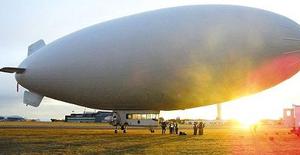Gulf of Mexico oil spillU.S. Navy blimp to help track oil flow in gulf
A U.S. Navy blimp arrived in the Gulf of Mexico yesterday to help detect oil, direct skimmers, and search for threatened wildlife; the blimp can carry as many as ten crew members as it flies slowly over the region to track the direction of the oil flow and how it is washing ashore

The slow airspeed of the blimp allows details including the oil type to be reported // Source: dcmilitary.com
A U.S. Navy airship arrived in the Gulf of Mexico Tuesday to help detect oil, direct skimmers, and search for threatened wildlife, officials said. U.S. Coast Guard officials said the blimp, known as the MX-3A, can carry as many as ten crew members as it flies slowly over the region to track the direction of the oil flow and how it is washing ashore, CNN reported.
“The aircraft get on top of the oil,” Coast Guard Capt. Brian Kelley said. “They can identify what type of oil it is and they can vector in the skimmer vessels right to the spot.”
UPI reports that efforts to clean up the oil that has been spilling into the gulf since a rig explosion 20 April have been stalled because of rough seas caused by Hurricane Alex as it churned across the southern gulf last week. The chop also hampered testing of A Whale, a converted oil tanker that is claimed to be capable of skimming between 15,000 and 50,000 barrels of oil off the sea in a day.
Officials in Texas, meanwhile, are expressing concern about the permanent disposal in Texas of oil and other waste generated from the gulf spill, the Houston Chronicle reported. Texas, home to several environmental services companies, refineries, and oil salvage operators, is one of several states recycling or disposing what is collected during cleanup efforts.
Officials said they were concerned about the type of waste coming in and how it was being processed.
Last week the U.S. Environmental Protection Agency (EPA) issued new directives to BP on recovered oil waste management, including guidelines on how to inform communities about waste being brought to their towns and requirements to provide access to waste facilities and detailed tracking reports.
Officials said Monday tar balls washed ashore on Louisiana’s Lake Pontchartrain and beaches near Galveston, Texas.
In Louisiana, a multi-tiered effort to protect Lake Pontchartrain is under way. John Lopez, a member of the Lake Pontchartrain Basin Foundation, said he has been studying models that try to predict the flow of oil, he New Orleans Times Picayune reported.
“I don’t want to be alarmist,” Lopez said. “I think what we’ll see will be very modest, and there’s a lot of protective measures.”
While the model predicts several days at a time, Lopez said the amount of time it will take to clean up the oil in the gulf after the well is capped and the flow of water in the area indicate oil could continue to enter the lake.
